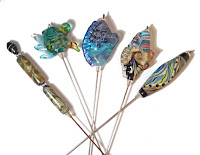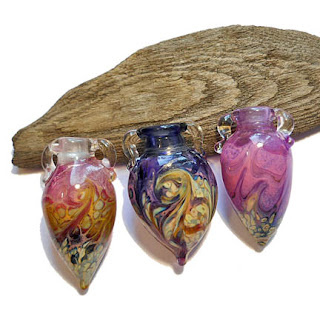 |
| Finito! |
Well, there are not photos of many of the steps taken to make this felted bowl, but let's see if I can explain how it all happened.
 |
| A few things gathered for use |
* Lay down a piece of plastic (like a bit of drop cloth) that is large enough to wrap completely around the finished piece.
* Cut a piece of flexible plastic stuff to act as a resist between the two sides and to build the pieces on. This was built flat and shaped into a bowl later.
* Add wool layers to the first side.
Begin with two layers of white for the background. This helps colors that will be added onto the final surface to pop.
A couple of wide lines of color that would contrast nicely with the
final surface were added. (A piece of thin foam will be placed over
those areas to keep them from
felting to the outer surface~ a cut will be made through one layer to
the next later.)
This was all wet down, soaped and prefelted and then flipped to
the other side before the final surface colors were added so that the
under colors and finished design could be carried from one side to the
other more effectively.
 |
| The first layer and bit of the other side |
* Flip over, wrap the edges of the wool around the resist and then
repeat the same process on the other side of the resist- 2 layers of
white, some contrasting color and prefelt. Finish this side out by covering the contrasting color bits with a flexible resist, then add the final layer of color.
* Back to the first side to add the final layer, covering the inside colors with flexible foam and then adding the final layer of colors, trying to somewhat match up the colors from one side to the next. The decision about which side would
be the top of the bowl would be made later.
These layers were then soaped, wet down and lightly prefelted (covered in plastic and rolled flat with a pool noodle) before the final layer of colors was added. I found in a subsequent bowl that four layers of wool on each side creates a nice, thick, sturdy bowl.
Add the final layer of colors and a little 'confetti'- random bits of stuff!
 |
| The second side |
* Wet down everything by spraying with soapy water and lightly felt by wrapping in plastic and rolling flat with the pool noodle about 50 times, covering the entire surface.
* Once all the colors are added, it's time to felt! Wrap everything carefully in plastic, keeping out wrinkles, and roll around a pool noodle, then roll a towel around the whole thing (you can also roll the towel up with the bowl for more felting friction; just be sure it will wrap all around the outside at the end).
 |
| Ready to felt! |
* Felt by wrapping completely in plastic and a towel and then wrapping
the whole mess around a pool noodle and rolling about 100 times in each direction.
i.e. roll 100 times, unwrap, turn, wrap and roll, repeat until it has
been rolled in every direction- NSEW, and then flipped and rolled all
four directions again.
* Check the felting progress as you go. When the felt is pulling on the resist, it's time to remove it. Cut a small hole (about 1 inch in diameter) out of the top center. Rub around the hole to expand and strengthen it, then carefully pull (manhandle) the resist out.
* Continue felting until everything is getting nice and firm. This can be done by wrapping and rolling for a bit longer. A piece of thin plastic (like a bag) can be placed inside just to ensure that things don't stick together where they should not. Cut carefully through the upper layer and remove the mini resists before finishing and fulling.
* Begin shaping into a bowl shape by felting with one hand on the inside. Finish the felting process in your usual manner. This was rinsed in cold water, then really hot water, then thrown down in the sink about 100 times, then rinsed in cold water with vinegar to remove all the soap, then really hot water, then cold again until it felt really well felted.
 |
| A different bowl |
* Put a plastic bag inside and stuff hard with newspaper, shaping the bowl as you go. Make a few ridges and clamp with clothespins or binder clips. Take this whole conglomeration and steam over boiling water for an hour or so.
* Leave the newspaper inside and clothespins on while the bowl begins to dry. Once it is mostly dry (overnight or longer), remove everything and let it finish the drying process.
Whew! That's a lot of instructions! Hope I didn't miss anything essential.
 Ah, so, the other day I was inspired to make some glass bird beads. Yes, I've tried this before and not been completely pleased with the results. This time I came up with a couple of different styles that I rather liked. Some were turned into earrings, others into ornaments~ all ready for the ornament blog hop! Click here to see other wonderful artisan made ornaments.
Ah, so, the other day I was inspired to make some glass bird beads. Yes, I've tried this before and not been completely pleased with the results. This time I came up with a couple of different styles that I rather liked. Some were turned into earrings, others into ornaments~ all ready for the ornament blog hop! Click here to see other wonderful artisan made ornaments.
 These are so easy to make~ you just need a rather heavy weight, long headpin and some complimentary beads. Line 'em up, make a loop and Bob's your uncle, you're ready to roll!
These are so easy to make~ you just need a rather heavy weight, long headpin and some complimentary beads. Line 'em up, make a loop and Bob's your uncle, you're ready to roll!














































